>> Back to The HooK front page
COVER STORY-Jim-Bob's thrown out; John-Boy pulls out: There's trouble on Walton's Mountain
Issue #21 of The Hook; published 06/27/02
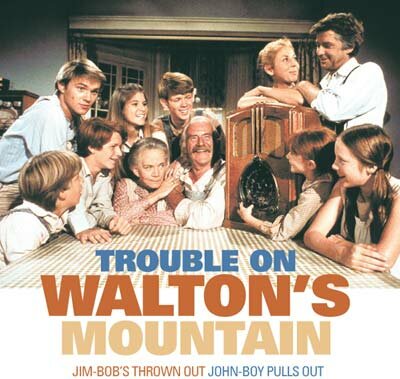
The Waltons
--CBS PHOTO ARCHIVE
BY LISA PROVENCE
In the early seventies, Earl Hamner Jr. limned his Depression-era childhood for what became one of the most beloved television series of all time. Thirty years later, The Waltons is still shown on TV, but now the real-life Walton's Mountain, the town of Schuyler, more closely resembles another famous television town: Peyton Place.
Allegations of embezzlement, drug use, and even illicit sex are running rampant in downtown Schuyler. Sides have been drawn. Among those on the outs are Hamner's own brother, Jim. Called "Jim-Bob" on the series, Jim Hamner has been kicked off the board of directors of the Walton's Mountain Museum.
In response, Earl Hamner has withdrawn his support from the museum he helped create as a gift to his hometown.
Is this the idyllic town Hamner immortalized for millions of television fans?
"It's gotten a black eye," says Hamner, adding that the allegations of inappropriate sexual conduct and embezzlement do not represent the values of The Waltons.
John-Boy's in your house
When The Waltons debuted on CBS in September, 1972, some network executives didn't think it had a chance. It was about a fictional family living in rural Virginia during the Depression. The show was up against Flip Wilson, one of the most popular comedians of the era, and The Mod Squad, a detective show with hip, young cops.
"Simple virtues are back in style,"proclaimed one critic as the series began a quick climb into the top ten. In its nearly ten-year run, the wholesome show racked up 13 Emmys and provided welcome escape from Watergate and the Vietnam War.
Richard Thomas played John-Boy, the character based on Earl Hamner (and the only living cast member who's never visited the Walton's Museum). Many fans felt and wished that John-Boy and his siblings Mary Ellen, Jason, Erin, Ben, Jim-Bob, and Elizabeth were part of their own families.
Each episode ended with a voice-over from Hamner himself over a night-time view of the homestead, and "Goodnight, John-Boy" became the show's signature line.
Now 78, Earl Hamner's filmography stretches from 1959 and includes screenplays for Charlotte's Web, The Homecoming, and Where the Lilies Bloom-- not to mention his 1968 version of Heidi that made television history when NBC execs infamously let it begin instead of airing the final 65 seconds of a close Jets v. Raiders football game. In 1993, Hamner was a co-producer on the television series Snowy River: The McGregor Saga.
What really happened in this tale of small-town politics, mudslinging, and personal vendetta that has split the community and threatens the existence of the museum that people come from all over the world to see?
"If you find out," says Hamner, "let me know.
The real Walton's Mountain
Jim Hamner still lives in the house in Schuyler where he and Earl and six other siblings grew up. It's across the street from the school they attended and just down the road from what was once Schuyler's biggest industry, a soapstone mill that employed 1,200 workers in its heyday.
The mill is a shadow of its former self, and economic opportunity for the community of 400 is scarce. Growing marijuana was perhaps the most profitable local industry-- one County administrator lost his job for growing pot in 1990.
After the Schuyler school closed in 1991, Woody Greenberg campaigned for the Nelson County Board of Supervisors with a pledge to save the old school as a Community Center. And it was Greenberg who came up with the idea to open a museum commemorating The Waltons.
Greenberg had gotten to know the Hamners from interviewing them when he worked as a reporter for the Daily Progress and the Nelson County Times.
Doris Hamner, Earl's mother, had told him that even without any publicity, fans had been making pilgrimages to Schuyler since shortly after The Waltons went on the air. Mrs. Hamner used to offer tea to visitors on her front porch.
"If you walked out of your house on a weekend," says resident Emma Ponton, "somebody would ask where Walton's Mountain was."
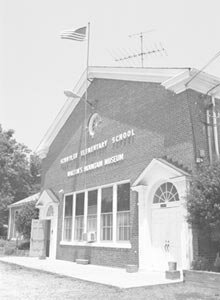
The Museum
--JEN FARIELLO
Greenberg saw the museum as a way to maintain and support an expensive, dilapidated old building. He flew to California and met with Earl Hamner, who contributed $10,000 to the project as well as memorabilia such as scripts and Emmys. Greenberg produced a videotape that's still being shown in the museum.
On opening day in 1992, over 6,000 fans jammed tiny Schuyler to catch glimpses of former cast members. The museum averaged 40,000 visitors a year, and took in almost $1 million its first three years, says Bill Luhrs, the museum's first director. Money from the nonprofit flowed back into the community in the form of a food bank donations and scholarships.
The museum, which took in $276,000 last year, also provided jobs. Its gift shop sells work by local craftsmen. A bed and breakfast opened below the Hamner home. The Schuyler Family Restaurant feeds the fans, and the C&P Market provides gas and snacks.
And yet, says Jim Hamner, "You'd be surprised at the number of people who don't want the museum and who want the Community Center back."
Certainly there have always been some who were less than thrilled with the steady stream of traffic drawn to the community.
"I can understand that buses and tourism are not organic to the area," says Earl Hamner, in a telephone interview from his Los Angeles-area office. "It saddens me that something that was intended to benefit the community has become so painful."
Hamner has now asked Greenburg to find a new home for his collection and says that eventually his belongings, which have been inventoried by the museum, will be moved out.
However, the folks who want the Community Center back don't want the museum closed. They want the museum open-- without the Hamners.
Jim-Bob's ouster
Schuyler today is not the same Schuyler Earl Hamner turned into a cultural icon in The Waltons, but time marches on, and "Jim-Bob," Jim Hamner, is now 66 years old. "There are very few people at 66 who sleep in the room they were born in," he points out.
Every day from his kitchen window he can glimpse people trying to peer in over the back fence. And sometimes when fans knock on the front door, he doesn't answer.
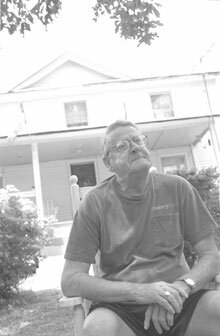
Jim Hamner
--JEN FARIELLO
Jim Hamner had known Judi Dudley and her family for years. It was on his recommendation that Dudley was hired to do some bookkeeping for the museum, according to board president Buck Whitehurst.
And it was her conviction for embezzling that led the board of directors of the Schuyler Community Center, the organization that runs the Museum, to vote Hamner out as its treasurer.
Earlier this year, Dudley was convicted of embezzling over $5,000 from Blue Ridge Services, a Charlottesville heating and air-conditioning company. On February 26, Hamner wrote a letter of recommendation to the judge before Dudley's sentencing.
So why would a seemingly compassionate gesture toward an old family friend turn the board against Hamner?
"It was written on museum stationery without the consent or knowledge of the board of directors," explains Whitehurst.
Hamner's letter claimed that Dudley worked for the museum 30 to 35 hours a week. In fact, says Whitehurst, it was more like 4 1/2 hours. "Jim's position was treasurer. He should have known how many hours she worked."
Even more damning, Dudley allegedly wrote two checks, totaling $627.50, on a museum account, and forged Hamner's and museum director Valda Mulkey's signatures, according to Whitehurst, Hamner, and a memo written by the Mulkey, the former museum director.
Why do they think it was Dudley who forged the checks?
"They were deposited into her account, and she signed the back of them," says Whitehurst.
Dudley's attorney, Ron Tweel, says his client is innocent. "You'd better be careful about what you put in that paper," he says, "or you're going to be looking at a lawsuit. They're just a bunch of bigmouths out in Schuyler."
"Then how come she served 60 days?" responds Blue Ridge Services proprietor Thomas Beasley. "She has a problem with currency; she doesn't know what's hers and what isn't."
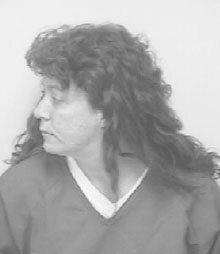
Judi Dudley's mugshot
--CHARLOTTESVILLE P.D.
Hamner still maintains that Dudley did a great job setting up the payroll for the museum, but "the board felt I should have known she was embezzling," he says.
"He says in his letter he was aware of her past," says Whitehurst. "If any other member of the board had done that, they would have been dismissed. That's just one instance. There are numerous other things he's done without board approval. There's a pile of dirt on him that's pretty deep."
Hamner, too, believes there are other reasons why he was axed from the board on March 26. "I think there's an agenda that we don't know about," he says
Certainly there are other elements to the story that have roiled Schuyler. Rumors of an intra-museum affair (not involving anyone named Hamner) are rampant in town, and accusations of substance abuse-- boozing and pot smoking-- have been lobbed by both sides.
Isis Ringrose, a staunch Hamner defender (as well as a psychic who, along with her husband, founded The Gathering, a spiritual community in Schuyler housed in the old hospital where Earl Hamner was born), calls Jim Hamner's ouster was "a power play."
If so, the balance of power may be shifting. On May 2, Earl Hamner wrote the board of directors.
"I learned recently that while representing me, a member of my family was caused pain, humiliation, and mental anguish at one of your meetings. Since my position on family relationships and obligations is well known, I am sure you will understand that I cannot continue to give you my support or allow you the use of my name."
All the "marbles"
Another casualty quickly followed Jim Hamner's dismissal as Community Center treasurer: the museum director.
"[Whitehurst] fired the director, Valda Mulkey, while she was on vacation," says Jim Hamner. An employee at the museum says the locks on the museum were changed after Mulkey's dismissal.
Whitehurst cites insubordination as the reason.
"Valda ambushed us," he says. At a general membership meeting May 6, Mulkey brought out Earl Hamner's note withdrawing his support. When someone asked if there was something they could offer Hamner to get him to reconsider, Mulkey said there was: Whitehurst's resignation.
"The intention was that I resign-- or Earl takes his marbles and goes home," recounts Whitehurst. "I said I'd be voted out, but not blackmailed."
A vote of confidence on Whitehurst's presidency was set. For one dollar, every one of the 600 residents of Schuyler is eligible to be a member of the Community Center.
The nearly 150 members were soon flooded with paper. Whitehurst compiled an information packet to help voters make "an informed decision." Mulkey, who declined comment for this story, sent out her own information packet dated May 10. Another letter came from Earl Hamner to the "people of Schuyler" urging them to vote for Whitehurst's removal. Hamner said Whitehurst misrepresented Hamner's withdrawal of support for the board as withdrawal of support for the museum.
The showdown between Whitehurst and the Hamners happened May 30 with 33 people voted to remove Whitehurst from the board and 49 voting to retain him, according to Whitehurst.
The results have left Hamner puzzled: "You don't know who your friends are," he says.
This sure wouldn't have happened in an episode of The Waltons.
Community Center v. museum
The vote that split the community claimed casualties on both sides.
Earl Hammer, 3,000 miles away in California, says, "It's too draining to get into a pissing contest with someone. I'm an old person. I've got other plays to write, other books to write."
"This has sucked up a lot of my time," says Whitehurst, who worries about negative publicity about "dumb rednecks" tossing John-Boy's baby brother from the museum board.
And a lot of residents are worried about the fate of the museum without the Hamners.
"You cannot have a Walton Museum without the Hamners," says Isis Ringrose. "It's like having a church without God."
Ringrose wrote a satirical letter to the Nelson County Times blaming Earl Hamner for causing all Schuyler's trouble by writing his successful television series in the first place. Some readers misunderstood the letter and didn't realize she was voicing her ire at Jim Hamner's removal from the museum's board.
Some residents want to see the museum become more of a Community Center. "The people of our community are alienated," says Whitehurst. "They call it the museum, not the Community Center."
However, Whitehurst says the Community Center faction doesn't want to shut down the museum. "Why would we want to shut down our only income-producing business?" he asks.
"The potential is so there," says Whitehurst, who believes the building is underutilized. "We want to do other things-- have raffles, play bingo. The building is only open from 10 to 4. It sits empty, and we're paying to heat it."
Whitehurst also wants to make the museum more interesting for the show's fans-- although he's concerned that attendance at a museum devoted to a 1970s TV show is bound to decline, particularly with an aging audience.
There's an underlying current, says Whitehurst, that "as long as the museum is running the way Earl and Jim want it, it's okay. If we don't play by their rules, they want to yank it."
Also, Whitehurst says, some of the disgruntled folks see the museum as benefiting only the people who work there.
Woody Greenberg, now the dean of communications and the arts at Lynchburg College, echoes that sentiment. "I suspect that to the people outside looking in, those running the museum are seen as a closed group."
And why has there been so much anti-Hamner backlash in the community with The Waltons as its major claim to fame, and where Earl Hamner still describes the people as kind, generous, and hospitable?
"All I can tell you from past experience is that there's some indication of jealousy," says Greenberg. "And there's some lack of appreciation for what intellectual property and creativity are."
The whole drama may have sparked literary aspirations in Whitehurst. He claims he wants to write a biography of the Hamners, only it won't be like The Waltons. "It'll be a soap opera," he says.
Can the museum survive without the Hamners? Whitehurst says the loss would be minimal if Earl Hamner removed his Emmys and his scripts, which occupy a room not open to the public anyway.
Louise Banton, who runs the museum's gift shop and whose sister and husband both resigned from the board after Jim Hamner was kicked off, isn't so sure. "That would kill us if we don't have his name," she says. "He was the Waltons."
She says the museum helps everyone in the community, and she worries how Schuyler would fare without it, particularly those whose crafts are sold in the gift shop.
"Most of the crafters are from the community," she says. "A lot depend on that money they get from that, especially the older ones."
"It'll be a relief to me when it closes," says Jim Hamner. "I don't see any chance for the museum to survive."
Earl Hamner acknowledges that he can't close down the museum.
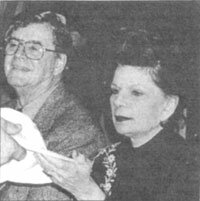
Earl Hamner with Ronnie Clair Edwards aka Cora Beth Godsey at a 1997 Museum event
--LINDA SHERMAN
And while Whitehurst thinks the museum can get along without Hamner's personal property, losing Hamner's endorsement would be a problem.
Greenberg says he tried to arrange a face-saving action to the board that was not successful.
"If we can get somebody to smooth it over with the Hamners," believes Louise Banton, "we might have a chance. There's nobody better than the Hamners. If it wasn't for Earl, it'd be a ghost town here."
Earl Hamner doesn't seem in too big a hurry to move his property from the museum. "Eventually," he says of his plans.
And despite all the turmoil over his legacy to Schuyler, "I'm very fond of that town," he says. "I'm going to be buried there."
#
>> Back to The HooK front page
|